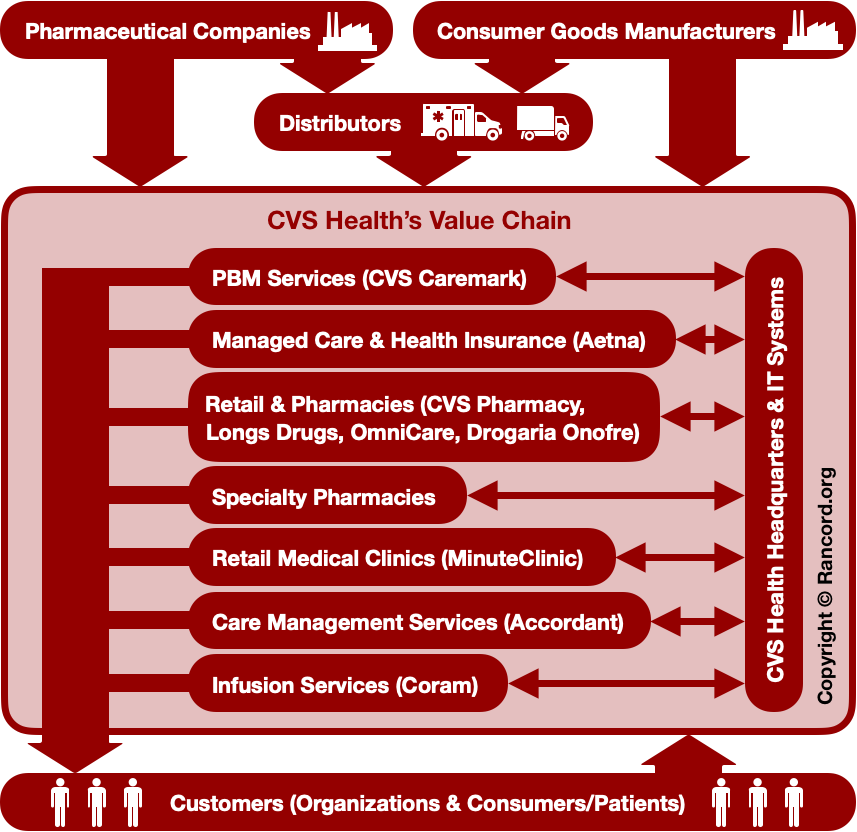
CVS’s value chain utilizes the enterprise’s core competencies to effectively create value for target customers, including organizations and individual consumers or patients. As one of the major competitors in the U.S. healthcare and retail pharmacy market, the company connects the consumer goods and pharmaceutical supply chains to customers, and in the process fulfills the cost savings value proposition. A value chain analysis of CVS Health Corporation determines how value is created for the benefit of the business and its customers, considering strategic objectives of satisfying clients’ health-related needs. In the resource-based view of the business, the VRIO/VRIN framework identifies the organizational resources and capabilities that are most significant in the retail pharmacy and healthcare company’s value chain and competitive advantage. In this regard, a VRIO/VRIN analysis of CVS Health Corporation determines which of these resources and capabilities function as core competencies that lead to long-term competitive advantages against other businesses, such as Walgreens, Rite Aid, and Express Scripts, as well as Walmart and other retailers. The effectiveness of these VRIO/VRIN resources and capabilities are reflected through CVS’s strong competitive power in the industry.
CVS’s value chain is an example of how demand aggregation can lead to bargaining power to optimize prices for consumers. The company essentially builds on aggregating consumer demand and expands its operations over time, to include the acquisition of firms like Aetna in the U.S. managed health care industry, and Drogaria Onofre in the Brazilian retail pharmacy market. In the resource-based view, this aggregation is made possible through CVS’s core competencies determined through the VRIO/VRIN analysis model.
CVS VRIO & VRIN Analysis, Table (Resource-Based View)
| CVS’S ORGANIZATIONAL RESOURCES & CAPABILITIES | V | R | I | O | N |
| Competitive Parity or Equality: | |||||
| Information technology resources for streamlining retail pharmacy and managed healthcare service operations | ✔ | ||||
| Temporary Competitive Advantages: | |||||
| CVS partnerships with large retailers like Walmart | ✔ | ✔ | |||
| Capacity to sustain competitive operations in overseas retail pharmacy markets | ✔ | ✔ | |||
| Unexploited Competitive Advantage: | |||||
| Capacity to operate large-scale healthcare facilities | ✔ | ✔ | ✔ | ||
| Sustained Competitive Advantages: | |||||
| CVS brand’s high value and popularity | ✔ | ✔ | ✔ | ✔ | ✔ |
| Economies of scale based on large market share | ✔ | ✔ | ✔ | ✔ | ✔ |
| Operational complementation | ✔ | ✔ | ✔ | ✔ | ✔ |
- This VRIO/VRIN analysis table is best viewed in HTML5-compatible browsers.
CVS’s Non-Core Competencies. The VRIN/VRIO analysis table lists four notable CVS organizational resources and capabilities that are non-core competencies. In the resource-based view of the healthcare and retail pharmacy business, these competencies do not provide competitive advantage because they do not satisfy all of the criteria of the VRIO and VRIN frameworks. For example, CVS’s information technologies are valuable (V) in the company’s value chain, but they do not satisfy the rarity (R), inimitability (I), organization (O), and non-substitutability (N) criteria. As a result, these technologies are non-core resources that provide only competitive equality (also known as competitive parity) relative to other retail pharmacy and healthcare companies. In relation, CVS’s partnerships with retailers and the capacity to expand overseas are imitable and do not satisfy all of the VRIO/VRIN analysis criteria and, thus, provide only temporary competitive advantage that competitors can catch up with. Of note in this resource-based view is the formulary and healthcare company’s unexploited competitive advantage identified in the VRIN/VRIO analysis table. Considering its organizational resources and capabilities, CVS has the capacity to establish large-scale healthcare facilities. However, the corporation’s value chain and related supply chain management operations are not fully organized around this competency. Still, these non-core competencies facilitate CVS’s generic strategy for competitive advantage and intensive growth strategies within the enterprise’s business model context.
VRIO Analysis of CVS’s Core Competencies (Sustainable Competitive Advantages). Applying the VRIO analysis framework and the resource-based view, the resulting table above identifies three organizational resources and capabilities that function as competitive advantages of the retail pharmacy and healthcare company. For example, the CVS brand’s high value and popularity is a core competency that satisfies all of the criteria of the VRIO framework. The brand is value, rare, imperfectly imitable (or legally inimitable), and the healthcare and retail pharmacy business is organized around capitalizing on this brand as an organizational resource to ensure the competitive advantage of its current and new products, and the operational effectiveness of its value chain. In relation, CVS’s value chain involves high economies of scale associated with a large healthcare and retail pharmacy market share in the United States. In the VRIO analysis framework, this organizational capability is a core competency that helps minimize costs, ensure profitability, and provide value in the form of affordability and convenience for customers. Furthermore, operational complementation, referring to the complementary nature of CVS’s divisions or subsidiaries, satisfies all of the VRIO analysis criteria. In the resource-based view, this core competency functions in maximizing the mutually benefitting value creation of the company’s subsidiaries, such as MinuteClinic and Aetna. As explained in the SWOT analysis of CVS Health Corporation, such complementation creates synergy that leads to optimal operational effectiveness, an effective value chain, and sustained competitive advantage. These resources and capabilities are also competitive advantages based on the VRIN analysis framework explained as follows.
VRIN Analysis of CVS’s Core Resources & Capabilities. The above table shows that the VRIO core competencies also satisfy the VRIN analysis criteria, which include the non-substitutability (N) of organizational resources and capabilities in contributing to the formulary and healthcare company’s competitive advantage. In the resource-based view, CVS’s brand is a non-substitutable resource that provides competitiveness based on popularity and brand recall among target customers. Also, this VRIN analysis points to the company’s economies of scale as an organizational capability functioning as a non-substitutable core competency, considering that there are benefits and business competitive advantages achievable only through such economies of scale. In CVS’s value chain, this core competency leads to cost minimization that sustains competitive advantages, such as in offering competitively priced healthcare plans. On the other hand, operational complementation is included as a core competency in this VRIN analysis, pertaining to the non-substitutable synergy created through the cooperative relationships among the company’s subsidiaries, as reflected through CVS’s organizational structure design. In the resource-based view, these organizational resources and capabilities are distributed and utilized throughout the healthcare and formulary company’s corporate structure and its components. CVS’s value chain involves various channels corresponding to these structural components and how they utilize the enterprise’s core resources and capabilities identified in this VRIN analysis.
Value Chain Analysis of CVS: How the VRIN/VRIO Resources & Capabilities Relate to the Value Chain
The following diagram simplifies CVS’s value chain, focusing mainly on the main business operations of the enterprise. In general, these healthcare and retail pharmacy operations utilize the core competencies shown in the VRIO/VRIN analysis table. Thus, in considering the resource-based view of the business and its competitive advantages, CVS’s value proposition is achieved through organizational resources and capabilities that create beneficial output for customers, as in the value-adding steps or activities illustrated as follows:

The CVS value chain diagram indicates the flow of inputs, such as goods or materials, from the supply chain to the customers, such as employers and their members. In this regard, supply chain management is a strategic factor affecting the healthcare and retail pharmacy value chain’s operational effectiveness. In analyzing CVS’s value chain, the diagram also points to the company’s value-adding activities as part of a set, which in turn is part of the larger system of value chains within the healthcare industry and the retail services industry, among other relevant industries. Thus, considering the resource-based view, CVS’s competitive advantages, value chain effectiveness, and VRIO/VRIN core competencies are under the influence of market-based and industry-based variables that include regulatory restrictions in the healthcare industry of the United States. Considering retail operations, CVS’s value chain also involves providing customers access to merchandise or consumer goods, such as personal care items and consumables like McDonald’s McCafé products. Thus, competitive bargaining power against manufacturers and suppliers influences the company’s ability to profit while benefiting consumers in its retail pharmacy stores. In addition, CVS’s organizational culture is a strategic factor in the operational effectiveness of this value chain, considering the cultural emphasis on giving back, which is reflected in how employees focus on satisfying consumers as stakeholders of the enterprise. In the resource-based view, this organizational culture supports competitive advantage via the human resource capabilities of the healthcare and retail pharmacy enterprise. Ultimately, the use of VRIN/VRIO resources and capabilities for value creation for customers addresses strategic objectives based on CVS’s corporate vision and mission statements.
Key Points: VRIO Analysis, VRIN Analysis & Value Chain Analysis of CVS
The organizational resources and capabilities that satisfy the criteria of the VRIO/VRIN analysis frameworks are shown to be the foundation of CVS’s competitive advantages. These resources and capabilities are part of the various value-adding processes of the business, indicating how the resource-based view relates to the retail pharmacy and healthcare company’s value chain. The value chain analysis of CVS provides insights on how the business utilizes its organizational resources and capabilities to fulfill its strategic objectives. The value chain diagram also serves as an analytical tool to determine possible opportunities to grow and expand the healthcare and formulary enterprise, based on potential new core competencies and competitive advantages involving operational activities. Also pertaining to the resource-based view of business inputs, CVS’s supply chain management is a strategic factor, considering the supply chain’s role in the company’s value chain. Based on the results of this VRIO analysis, VRIN analysis, and value chain analysis, strategic objectives and strategic planning must maximize competitive advantages to enhance value chain effectiveness and overall value creation in CVS’s operations and potential business expansion.
References
- Akis, E. (2015). Innovation and competitive power. Procedia-Social and Behavioral Sciences, 195, 1311-1320.
- Barney, J. B. (2017). Resources, capabilities, core competencies, invisible assets, and knowledge assets: Label proliferation and theory development in the field of strategic management. The SMS Blackwell Handbook of Organizational Capabilities, 422-426.
- CVS Caremark’s Website.
- CVS Health Corporation – CVS Health Announces 2018 Formulary Management Strategy.
- CVS Health Corporation – CVS Health Completes Acquisition of Aetna, Marking the Start of Transforming the Consumer Health Experience.
- CVS Health Corporation – CVS Takes Additional Steps to Ensure the Continued Integrity of the Pharmaceutical Supply Chain.
- CVS Health Corporation’s Annual Report to the U.S. Securities and Exchange Commission.
- CVS Pharmacy’s E-commerce Website.
- Dekker, H. C. (2003). Value chain analysis in interfirm relationships: A field study. Management Accounting Research, 14(1), 1-23.
- Donaldson, K. M., Ishii, K., & Sheppard, S. D. (2006). Customer value chain analysis. Research in Engineering Design, 16(4), 174-183.
- Huggins, R., & Izushi, H. (Eds.). (2011). Competition, competitive advantage, and clusters: The ideas of Michael Porter. Oxford University Press.
- International Trade Administration of the U.S. Department of Commerce – The Retail Services Industry in the United States.
- Knott, P. J. (2015). Does VRIO help managers evaluate a firm’s resources? Management Decision, 53(8), 1806-1822.
- Pesic, M. A., Milic, V. J., & Stankovic, J. (2013). Application of VRIO framework for analyzing human resources’ role in providing competitive advantage. Tourism & Management Studies, 575-586.
- Schroeder, A., & Kotlarsky, J. (2015). Digital resources and their role in advanced service provision: A VRIN analysis. In Proceedings of the Spring Servitization Conference (pp. 67-74). Aston University.
- Sürie, C., & Wagner, M. (2005). Supply chain analysis. In Supply Chain Management and Advanced Planning (pp. 37-63). Springer, Berlin, Heidelberg.
